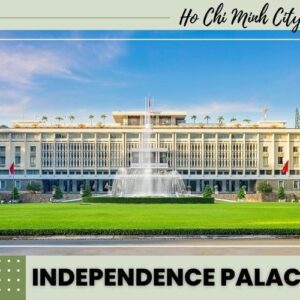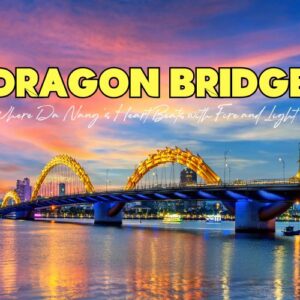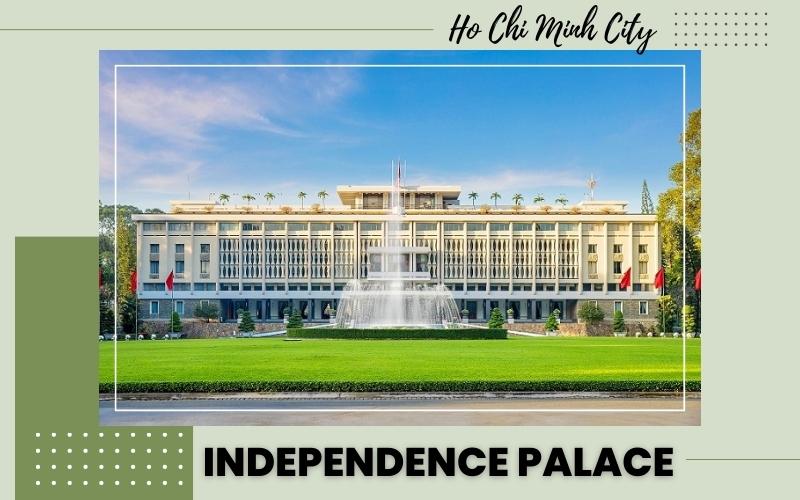
The Independence Palace (also known as Reunification Palace) is an important historical monument in Ho Chi Minh City, Vietnam. It stands as a silent witness to the magical development of Saigon’s history throughout the Vietnamese War.
Essential Information for Tourists
The Independence Palace is located at No.135, Nam Ky Khoi Nghia Street, Ben Nghe Ward, District 1, Ho Chi Minh City. It spans a sprawling 120,000 square meters (300 meters x 400 meters). Situated at its peripheries are four prominent streets: Nam Ky Khoi Nghia Street to the northeast, Huyen Tran Cong Chua Street to the southwest, Nguyen Thi Minh Khai Street to the northwest, and Nguyen Du Street to the southeast.
This grandeur is complemented by its adjacency to 30-4 Park at the front and Tao Dan Cultural Park at the rear. Within the Palace’s premises, an array of ancient trees, some tracing their origins back to the French colonial era, flourish. For aficionados of art and architecture, this Reunification Palace stands as a captivating gem in the tapestry of Ho Chi Minh City attractions.
- Opening hours: 07:30 AM – 11:30 AM and 01:00 PM – 05:00 PM
- Entrance Fees: 40,000 VND/adult, 20,000 VND/student, and 10,000VND/child
History of Independence Palace
The construction of the Reunification Palace traces back to 1858, a pivotal year marked by French colonial forces initiating an assault on Da Nang, which marked the inception of their aggressive campaign against Vietnam. By 1867, the French had asserted control over six provinces: Bien Hoa, Gia Dinh, Dinh Tuong, Vinh Long, An Giang, and Ha Tien. In 1868, the French government commenced the design and construction of a grand mansion at the heart of Ho Chi Minh City, intended as the residence for the Governor of Cochinchina. Upon its completion, it earned the designation of Norodom Palace.
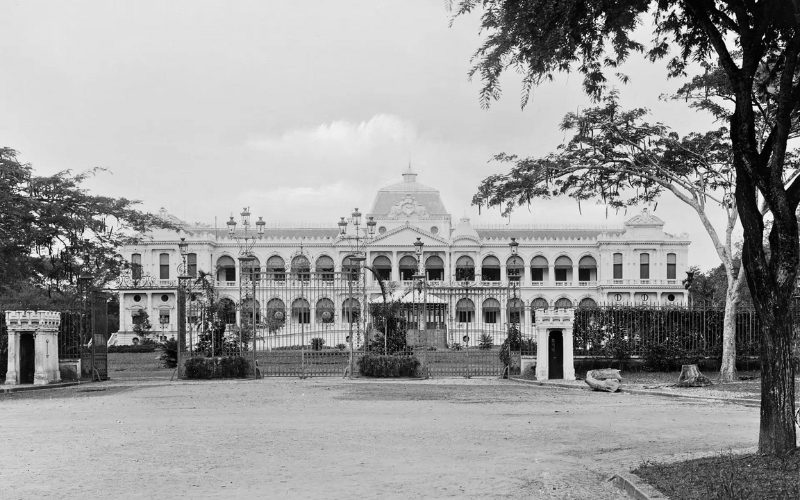
Norodom Palace in 1896
Fully realized in 1871, the mansion served as a domicile and workplace for various French governors during the period from 1887 to 1945, spanning the Indochina era. As Japan’s influence ascended in 1945, the Palace transformed into the administrative center of the Japanese government in Vietnam.
The close of 1945 saw the French colonialists falter in the Dien Bien Phu campaign, compelling them to sign the Geneva Agreement and withdraw their troops from Vietnam. The baton of the Norodom Palace was exchanged between representatives of the French government and the Saigon government on September 7th, 1954. It was Prime Minister Ngo Dinh Diem who opted to rename the edifice as Independence Palace.
In 1955, Ngo Dinh Diem assumed the presidency of Vietnam. He conducted a family-ruled dictatorship and had Vietnamese people live in strategic hamlets, leading to discontent among people and the Saigon Government. As a consequence, protesters severely damaged over half of the Palace’s left side, forcing Ngo Dinh Diem to oversee its reconstruction.
Ultimately, during the historic Ho Chi Minh campaign of 1975, Vietnam achieved triumph and national reunification. The Independence Palace served as the epicenter where the Vietnamese Revolutionary Army secured their victory. Today, this place stands as a revered national monument, drawing countless domestic and international visitors. It also functions as a meeting point for guests of all tiers and city leaders.
Unique Architecture of Independence Palace
In 1967, Architect Ngo Viet Thu was selected to execute the design of the Reunification Palace. He became the first Vietnamese individual to claim the prestigious Khoi Award in architecture, a distinction that remains singular to this day.
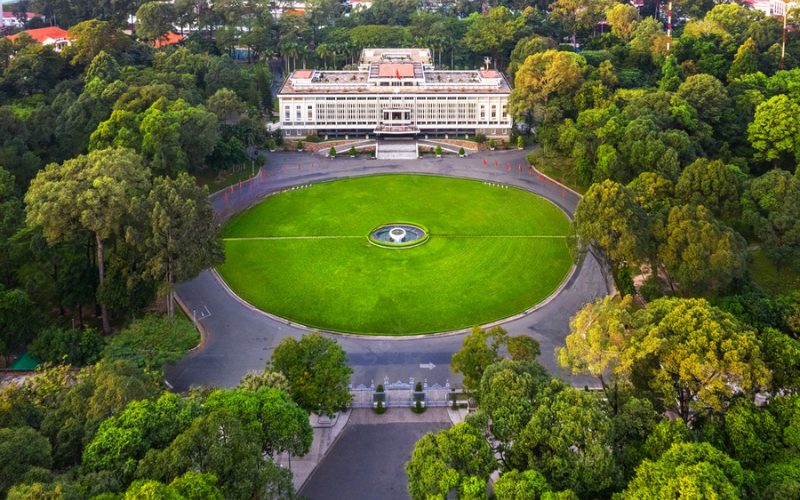
An aerial view of the Independence Palace
Encompassing an expansive expanse of 12 hectares, the construction occupies a notable space, featuring a grand mansion spanning 80 meters in width. Within the Palace’s confines, a capacious reception hall capable of accommodating 800 individuals stands, complemented by sprawling grounds adorned with numerous trees and verdant lawns.
The Palace’s architectural magnificence further manifests through the stone flower curtain adorning the second floor, crafted in the graceful semblance of bamboo. Drawing inspiration from the entrance gates of the Hue Imperial Palace, this stone flower curtain serves to augment not only the Imperial Palace’s allure but also radiates brilliantly when kissed by sunlight.
The Exterior
Located on the Palace’s front yard rests an oval lawn, boasting a diameter of 102 meters. The lush, verdant expanse of grass forms a tranquil and rejuvenating ambiance for visitors the moment they cross the threshold. A semi-circular lake gracefully traverses the width of the yard, graced by the presence of lotus flowers and water lilies. These elements conjure a serene atmosphere akin to the placid lakes within Vietnam’s ancient temples and pagodas.
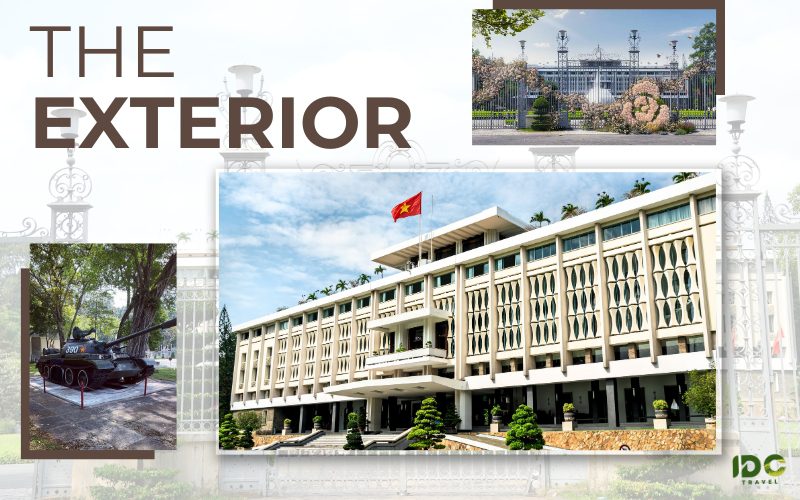
The exterior of the Independence Palace
Flanking the Independence Palace’s front and rear perimeters, you’ll find two verdant parks. The main building, a sprawling architectural marvel, stands tall with three floors, two mezzanines, one terrace, one ground floor, and a basement. The entirety of this structure spans a generous 20,000m² and encompasses 95 rooms. Each room serves a distinct purpose, its architecture and decoration meticulously tailored to its function. Post-1975, certain rooms within the main building continue their utilization, while others are repurposed to cater to visitors.
On the side facing Nguyen Thi Minh Khai Street, an octagonal structure with a 4-meter diameter sits atop an elevated mound. It features an age-old curved tile roof, creating a tranquil oasis for relaxation and cool reprieve. Surrounding the Palace, the landscape flourishes with lush lawns, time-honored gardens, cherished potted plants, and an ensemble of four tennis courts tucked behind the primary edifice.
The distinct hallmark of this mansion’s architecture owes its creation to the ingenious mind of architect Ngo Viet Thu. With finesse, he interwove modern architectural artistry with traditional Oriental design principles, yielding a remarkable masterpiece.
The Interior
Within the Reunification Palace’s confines, the architecture boasts an astonishing beauty that’s bound to leave even the most stoic visitor in awe. The centerpiece of the hall is flanked by the oat room and the cabinet meeting room, with a grand, solemn wooden staircase commanding attention at the forefront. This expansive hall boasts lofty dimensions, a sense of space that’s both expansive and airy, adorned with unpretentious yet intricate embellishments. Upon entering through the main gate, a meandering path around the oval grass leads the way to the palace.
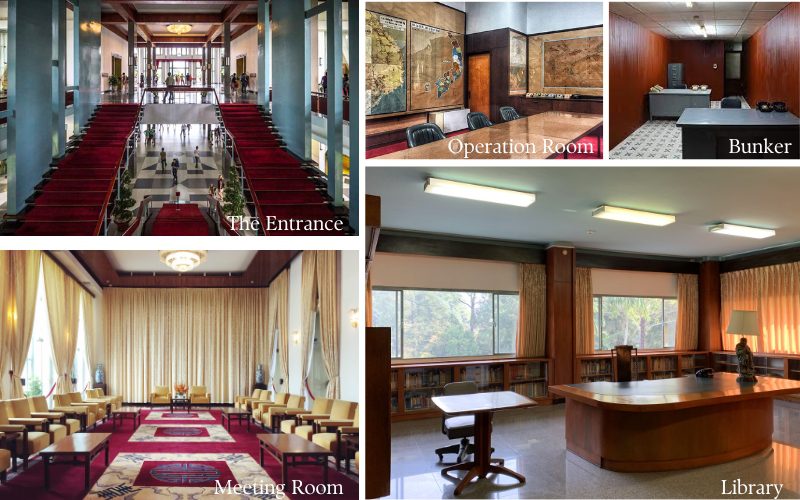
The interior of the Independence Palace
Beyond the remarkable staircase and hall, each room within the Reunification Palace unveils a unique and magnificent charm.
- The Chamber: With a capacity exceeding 500 people, this space was once the backdrop for meetings, receptions, and cabinet inaugural ceremonies.
- The Credential Referral Room: An unique feature is the painting titled “Binh Ngo Dai Cao,” translating to “The Proclamation of Victory,” depicting 40 vignettes portraying peaceful Vietnamese life during the 15th century.
- Library: Here, a wealth of books and research papers belonging to past presidents find their place.
- Strategic Operations Department Room: This room served as the repository for military intelligence from the four tactical regions. Using a combat map system, staff updated, monitored, and devised military operational strategies.
- Basement: Beneath the Independence Palace lies a basement, designed by Lieutenant Colonel and Engineer Phan Van Dien, the Chief of the Independence Palace. The tunnel spans 72.5 meters in length, with a width ranging from 0.8 to 2.25 meters and depths from 0.6 to 2.5 meters. The basement rooms are interconnected by small concrete entrances, and fortified walls, and outfitted with ventilation systems.
- Numerous other rooms, such as the ballroom, the Presidential family’s residence, the movie room, and the reading room, are sure to pique the curiosity of visitors.
Additional sections within the Reunification Palace are accessible to visitors. Among these is the Thematic Area, an exhibition space that showcases aged artifacts and photographs. Here, visitors can not only relive the past through vivid images but also delve into the historical minutiae concealed within. These artifacts are the fruits of the diligent research and exploration carried out by historical experts.
Of special note is the “From Norodom Palace to Independence Palace, 1868 to 1966” exhibition area within the Independence Palace. This captivating attraction is a treasure trove for history enthusiasts, as it chronicles the evolution, construction, significant milestones, and pivotal events that unfolded at the Independence Palace.
Another facet of the Palace encompasses the supplementary area, housing a collection of discovered and subsequently preserved photographs. These images, on display here, were safeguarded by individuals from the resistance period to the era of independence. They were entrusted to the Palace as a means to conserve and convey this legacy to generations yet to come.
What to See in the Independence Palace
Historical Artifacts
The historical relics housed within the Reunification Palace encapsulate the valiant narrative of Vietnam’s past. These objects are meticulously preserved, ensuring their impeccable condition for visitors to witness and appreciate.
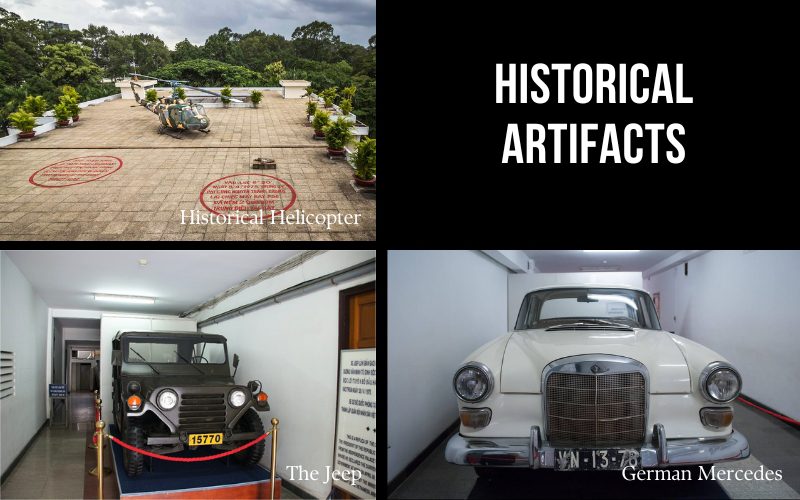
Historical artifacts
- Historical Helicopter: Atop the Reunification Palace, an exhibit showcases President Nguyen Van Thieu’s UH-1 helicopter, placed adjacent to the spot where two bombs thrown by pilot Nguyen Thanh Trung once detonated.
- German Mercedes: A German Mercedes Benz 200 W110, bearing the license plate VN-13-78, stands as a testament. This automobile was part of the fleet used by President Nguyen Van Thieu of Vietnam.
- The Jeep: The Jeep M152A2, employed by the Revolutionary Forces, holds unique significance as the conveyance that transported the final President of the Vietnam regime, Mr. Duong Van Minh. It carried him to the Saigon radio station, where he proclaimed surrender on April 30th, 1975.
Artworks
The Reunification Palace not only showcases historical artifacts but also presents an array of valuable artworks.
- Oil Paintings: Among these, an oil painting by architect Ngo Viet Thu captures the essence of the Vietnamese countryside. Another oil painting portrays the poignant encounter between the sisters Thuy Kieu and Thuy Van and Kim Trong on Ancestors Day, also known as the Festival of Tending Graves.
- Pottery: The Independence Palace is also home to numerous ancient Chinese pottery vessels dating back to the Ming and Qing periods.
Historical Tanks
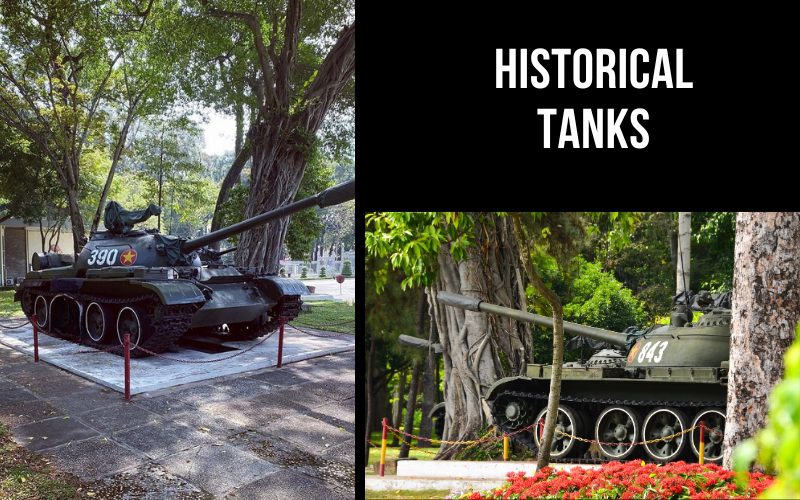
Historical tanks
The model-843 tank, crafted in Russia, was the first tank to attempt to breach the gates of the Independence Palace in April 1975. Despite its efforts, the gate remained unyielding. It was the model-390 tank that ultimately overcame the gate, advancing into the palace’s main yard.
This event, a pivotal juncture in history, symbolized the triumph of the extensive Ho Chi Minh revolutionary effort, culminating in Vietnam’s official reunification and attainment of independence. The two tanks displayed within the Palace’s yard are replicas of the original ones, currently showcased in Hanoi.
Important Notes when Visiting the Independence Palace
- The Reunification Palace stands as a dignified repository of Vietnam’s heroic history, so visitors are kindly requested to adhere to the monument’s regulations for the sake of respect and preservation:
- Wear formal clothes; kindly refrain from wearing skirts or shorts
- Heed the guidance of guards and signage throughout your visit
- Please refrain from carrying baggage into the monument
- Kindly avoid bringing food or beverages into the monument
- Animals are not permitted within the monument’s premises
- The monument prohibits the entry of weapons, explosives, and toxic substances
- Take responsibility for any inadvertent damage caused to the monument during your visit
The Reunification Palace stands as both a courageous emblem of Ho Chi Minh City and a source of immense pride for the Vietnamese nation. Embarking on a journey through this historic landmark promises an unforgettable encounter, particularly for international guests intrigued by Vietnam’s valiant history. For those with a penchant for history, this destination is an absolute must-visit, brimming with significance and tales of valor. Don’t forget to browse its official website for a visual overview of what you can see here. And, don’t hesitate to contact us to plan your trip now.

